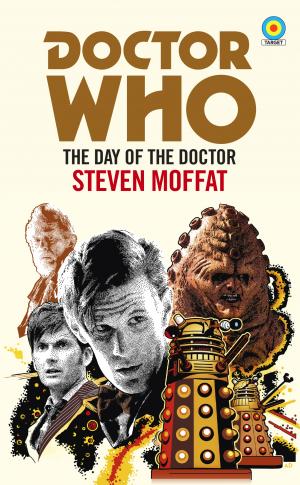
Author: Steven Moffat
Publisher: BBC Books
Released: April 2018
Paperback: 232 pages
The 11th Doctor’s entry into the Target books range sees Steven Moffat novelise his 50th-anniversary celebration with two closely intertwined plots in a timey-wimey multi-Doctor tale. The first plot strand sees the Doctor joining forces with his previous incarnation and the recently introduced War Doctor to thwart the Zygons who, having found themselves in Elizabethan England, hatch a plot to take over the Earth in the future. However, the second plot strand which sees the Doctor confront his role in ending the Time War is more significant, addressing a major theme running throughout the series since its return in 2005. This is arguably given even more weight in this novelisation than in the televised version, exploring the pain arising from his actions in a more personal way. In revisiting the response of his Ninth incarnation at the end of The Parting of the Ways however, this book makes the point that the choice the Doctor faced here is the same impossible choice he has faced on many occasions.
This is the longest of this new batch of novelisations, perhaps understandably given the extended running length of the TV episode and the multiple plot lines, but also given that it covers the brief prequel, ‘the Night of the Doctor’. Add to these the addition of new material and this feels a more substantial novel than the other recent releases in this range. It also has a very different feel to it, demonstrating the versatility of earlier entries into the Target range. Here, each chapter is written from the perspective of a different character, often in the first person, making each one feel fresh while challenging the reader to work out the identity of the author. This story-telling device is put to particularly good effect when recounting the Doctor’s journey to the Tower from the perspective of each of his incarnations in turn – a journey his later incarnations have obviously experienced before. It also allows for the injection of some humour at the expense of the Doctor and other characters, the former being variously identified as Bow Tie, Daddy’s Suit, Pinstripe, Grumpy, and Neckwear. (As a side point, reference to the Tenth Doctor’s ‘tight suit’ would surely become a standard Target description of this Doctor should the range be extended, much like the Fifth Doctor’s “pleasant, open face”). Each chapter is also preceded by a communication to readers from the narrator, an archivist who seems to be piecing together events in the story. For me, the style of these interludes seemed very similar to those of Moffat’s DWM Production Notes. I anticipate that this may grate with some readers and might be expected to interrupt the flow of the story, but for me these did make for refreshing breaks and a lightening of the mood in some of the book’s more serious moments.
Moffat also takes the chance to add to his original story, the most notable addition being that of a small but not insignificant role for River Song, perhaps understandable as one of his most significant character creations. There is also an extended description of the Doctor’s integration in the Court of Queen Elizabeth and, of course, reference to Chapter 9 which claims to resolve so many of the show’s big questions and controversies is a typical example of Moffat playfulness. He has further fun with the first two Doctors here being identified as colour blind and the Doctor also refers to the Peter Cushing Dr Who films and is even reported to be consulting with Cushing on a third film.
As one would expect from an anniversary story there is lots of fan-pleasing continuity with references to the great and the good from the show’s past, including Ian and Barbara, The Brigadier, Sarah Jane Smith and Susan. The grand finale still sees all the Doctor’s incarnations join forces though here it is in a somewhat different manner to the TV episode and a significant addition comes right at the end of the book with a brief postscript featuring the thirteenth Doctor. And as with many Target novelisations this one also takes the opportunity to extend the roles and significance of supporting characters - here Queen Elizabeth and McGillop are the main beneficiaries. The absence of the Daleks is though more apparent in this book. Although they are an important part of the backdrop to the story in terms of the Time War – without the impact of their on-screen cameos they are effectively absent here.
This novel then has more serious undertones than the first two additions to the Target range but is not without its moments of humour, which, as in past multi-Doctor stories are principally in the interactions between the various incarnations of the main character. It is a book written very much with fans of the series at its heart, but going beyond the continuity this is never clearer than the beautiful moment when the War Doctor promises that whoever hears the wheezing, groaning sound of the TARDIS will know that they are not alone. While this is of immediate significance to the Doctor in the context of the story, this is surely also speaking to the fans and their relationship with the Doctor. The Day of the Doctor immediately soared to the top of the DWM poll of TV stories and I’m sure this novelisation will be held in similarly high regard.







